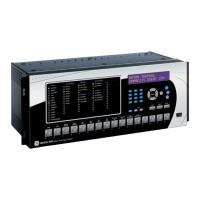GE Multilin M60 Motor Protection System 5-95
5 SETTINGS 5.2 PRODUCT SETUP
5
Teleprotection inputs/outputs and direct inputs/outputs are mutually exclusive – as such, they cannot be used
simultaneously. Once teleprotection inputs and outputs are enabled, direct inputs and outputs are blocked, and vice
versa.
• NUMBER OF TERMINALS: Specifies whether the teleprotection system operates between two peers or three peers.
• NUMBER OF CHANNELS: Specifies how many channels are used. If the NUMBER OF TERMINALS is “3” (three-terminal
system), set the NUMBER OF CHANNELS to “2”. For a two-terminal system, the NUMBER OF CHANNELS can set to “1” or
“2” (redundant channels).
• LOCAL RELAY ID NUMBER, TERMINAL 1 RELAY ID NUMBER, and TERMINAL 2 RELAY ID NUMBER: In installa-
tions that use multiplexers or modems, it is desirable to ensure that the data used by the relays protecting a given line
is from the correct relays. The teleprotection function performs this check by reading the message ID sent by transmit-
ting relays and comparing it to the programmed ID in the receiving relay. This check is also used to block inputs if inad-
vertently set to loopback mode or data is being received from a wrong relay by checking the ID on a received channel.
If an incorrect ID is found on a channel during normal operation, the
TELEPROT CH1 ID FAIL or TELEPROT CH2 ID FAIL
FlexLogic operand is set, driving the event with the same name and blocking the teleprotection inputs. For commis-
sioning purposes, the result of channel identification is also shown in the
STATUS CHANNEL TESTS VALIDITY OF
CHANNEL CONFIGURATION actual value. The default value of “0” for the LOCAL RELAY ID NUMBER indicates that relay ID
is not to be checked. On two- terminals two-channel systems, the same LOCAL RELAY ID NUMBER is transmitted over
both channels; as such, only the
TERMINAL 1 ID NUMBER has to be programmed on the receiving end.
5.2.18 INSTALLATION
PATH: SETTINGS PRODUCT SETUP INSTALLATION
To safeguard against the installation of a relay without any entered settings, the unit will not allow signaling of any output
relay until RELAY SETTINGS is set to "Programmed". This setting is defaulted to "Not Programmed" when at the factory. The
UNIT NOT PROGRAMMED self-test error message is displayed until the relay is put into the "Programmed" state.
The
RELAY NAME setting allows the user to uniquely identify a relay. This name will appear on generated reports.
INSTALLATION
RELAY SETTINGS:
Not Programmed
Range: Not Programmed, Programmed
MESSAGE
RELAY NAME:
Relay-1
Range: up to 20 alphanumeric characters

